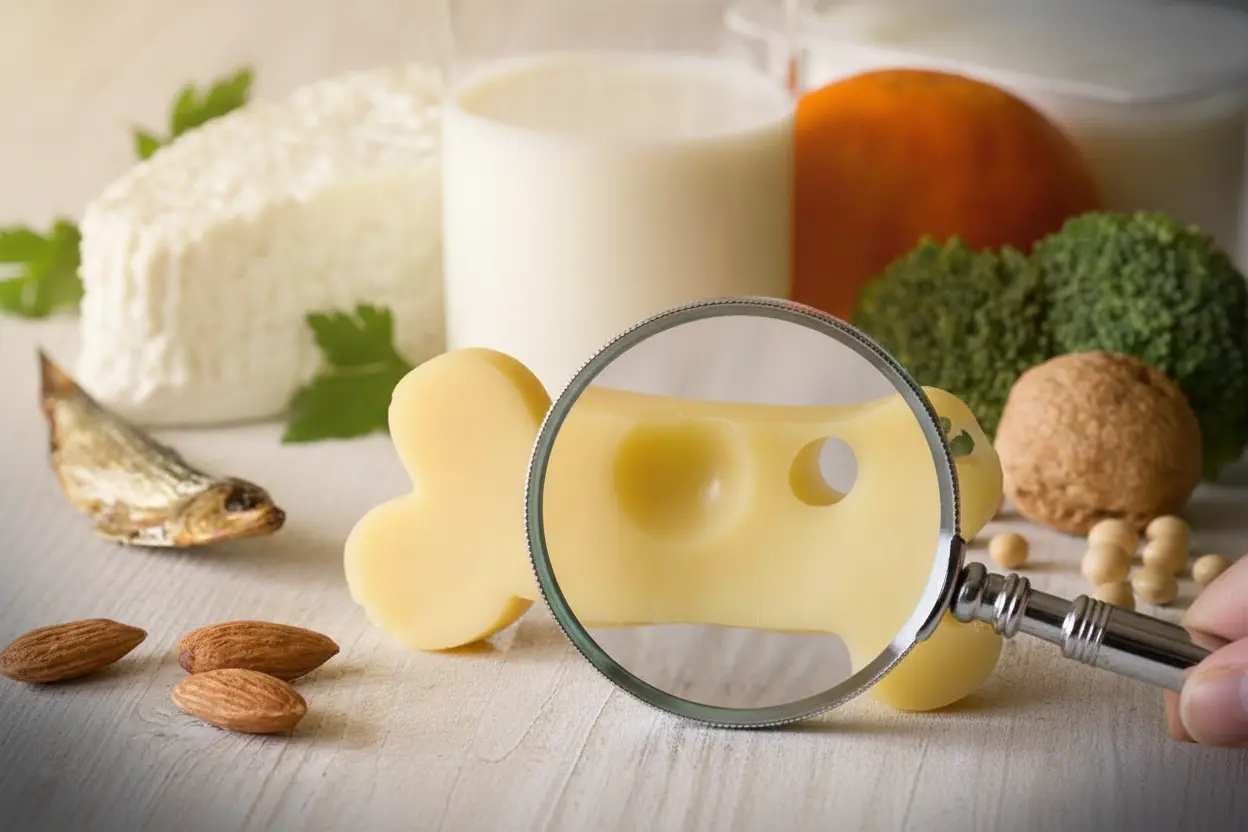The Essential Balance: Calcium, Phosphorus, and Your Bones
According to Gruman,
« Let’s remember first and foremost: calcium is the mineral superstar behind bone solidity. It ensures their mechanical strength and helps with the constant renewal of bone tissue. »
Around 98% of our body’s calcium reserves are in our bones. Every single day, your body « withdraws » a little for crucial functions like muscle contraction, blood clotting, and nerve transmission—meaning your diet has to top it back up on the regular.
Phosphorus works hand in hand with calcium to form hydroxyapatite crystals, essential for bone structure and strength. But here’s the catch: you need to keep your calcium-to-phosphorus ratio in balance—ideally, 1 to 1. If you get too much phosphorus (say, from lots of meat, fish, or eggs), your body pulls calcium from your bones to compensate, making your skeleton more fragile. The golden rule? A steady intake of calcium (think dairy, mineral water, veggies) and phosphorus keeps your bones robust and your metabolism running smoothly.
Foods That Can Undermine Your Bones
- Salt: When consumed in excess, salt speeds up the loss of calcium through your urine, chipping away at your body’s calcium stores. There’s no need to go full no-salt, but keep processed foods, cured meats, and cheese in check—and go easy on table salt.
- Alcohol: Booze isn’t just bad for your liver; too much of it dulls the activity of osteoblasts (the cells that build bone) and speeds up bone demineralization.
- Caffeine: Overdoing the caffeine (more than three cups of coffee per day) can also make you lose more calcium in your urine—so best to keep it moderate.
- Phytates & Oxalates: These so-called “antinutritional factors” in certain foods actually bind to the calcium you eat, blocking its absorption. Phytates lurk in whole grains, legumes, seeds, and nuts, while oxalates are found in spinach, rhubarb, beets, cocoa, black tea, and almonds. But don’t go tossing these foods out yet—they also provide fiber, vitamins, minerals, and antioxidants. The advice? Don’t make them your only source of fiber or veggies, and try not to pair calcium-rich foods with oxalate- and phytate-rich ones at the same meal, if possible.
Calcium Champions: Dairy and Mineral Water
Dairy and dairy products are top-notch sources of easy-to-absorb calcium, making them valuable allies in the fight against osteoporosis—as long as your overall diet is balanced and you’re getting enough vitamin D. Gruman explains,
« Dairy calcium is highly bioavailable—about 30 to 35% is absorbed—but don’t forget, calcium needs vitamin D to lock into your bones. That’s why a vitamin D supplement in winter, when sunlight is scarce, is good for everyone.”
People with increased calcium needs—like kids, seniors, or postmenopausal women—might need vitamin D year-round.
Foods and milks fortified with vitamin D are increasingly available and can be a clever addition to the shopping list.
And for those who don’t do much dairy—whether you’re lactose intolerant or vegan—don’t fret: certain mineral waters can make a big dent in your calcium needs. Water is considered “calcium-rich” if it contains more than 150 mg of calcium per liter. For example, brands like Hépar (550 mg/L), Contrex (460 mg/L), Courmayeur (570 mg/L), Talians (290 mg/L), and Vittel (240 mg/L) are especially rich. (Note: brands and measures are European; check U.S. equivalents if you’re looking local.) Getting about half a liter—about 17 ounces—a day of these waters can deliver 25 to 30% of an adult’s daily calcium needs, which is great news for non-dairy folks.
Absorption of calcium from mineral water is similar to that from dairy—especially if the water is carbonated (thanks, bicarbonate!). But the “still” waters with the most calcium pack over twice as much as carbonated options, making them at least as valuable for bone health.
Don’t Forget Exercise: Bones Love a Challenge
Bones aren’t just static: they’re living tissue, constantly renewing and getting stronger in response to mechanical stress. Every footstep, every muscle pull stimulates bone-building osteoblasts to produce ossein, which helps stiffen up your skeleton. The best activities? Moderate-impact moves like brisk walking, dancing, hiking, stair climbing, and energetic exercise classes benefit bones even more than low-impact sports like swimming or cycling (which are gentler but don’t work the bones as hard).

John is a curious mind who loves to write about diverse topics. Passionate about sharing his thoughts and perspectives, he enjoys sparking conversations and encouraging discovery. For him, every subject is an invitation to discuss and learn.






